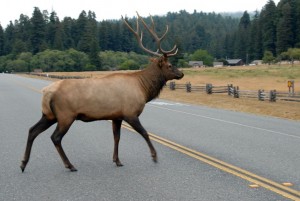 According to the National Highway Traffic Safety Administration (NHTSA) there are about 1 million collisions with deer each year, injuring more than 10,000 people and killing about 200. And that’s just counting deer. Collisions with elk, moose, bear, and other wildlife can also result in serious injuries and death. Collisions with wildlife peak during mating season, or rut. For deer in North America, rut lasts from late October through early December. Of course, wildlife may be seen on the road any time of year. You can minimize your risk of being involved in a tragic collision by taking a few precautions.
According to the National Highway Traffic Safety Administration (NHTSA) there are about 1 million collisions with deer each year, injuring more than 10,000 people and killing about 200. And that’s just counting deer. Collisions with elk, moose, bear, and other wildlife can also result in serious injuries and death. Collisions with wildlife peak during mating season, or rut. For deer in North America, rut lasts from late October through early December. Of course, wildlife may be seen on the road any time of year. You can minimize your risk of being involved in a tragic collision by taking a few precautions.
Tips for Avoiding Collisions with Wildlife
- Be on highest alerts for wildlife in the road at dusk, dawn, and in the first few hours after sunset.
- Use your high beams whenever possible.
- If one crosses the road, others will follow and you may not see them coming.
- Be prepared for deer and other wildlife to quickly change direction, darting in front of your car at the last second.
- Dim your dashboard lights slightly so you can spot eyes reflecting your headlights more easily.
- If you see one there are probably more close by.
- Constantly scan the sides of the road for wildlife as you drive.
- Do not swerve. Hit the brakes instead.
- Use extra caution in areas posts with wildlife crossing signs.
- Do not assume that there will not be wildlife in areas that are not posted.
- Use extra caution in areas where a stream passes under the road.
















